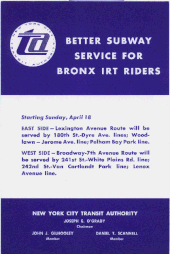5 (New York City Subway service)
Its route emblem, or "bullet", is colored forest green since it uses the IRT Lexington Avenue Line in Manhattan.
The 5 short turns at Bowling Green in the Financial District of Manhattan during weekday evenings and weekends during the day and does not operate to or from Flatbush Avenue.
The section between Dyre Avenue and East 180th Street, which was acquired from the defunct New York, Westchester and Boston Railway and started operating as a shuttle in 1941, was connected to the rest of the subway in 1957 and became part of the 5 in 1965.
[18]: 59–60 Plans were made for restoring the old line north into Westchester County, but ultimately failed,[19] and the superfluous track and overhead catenary on the old NYW&B were scrapped by 1943.
[20] The section below East 180th Street to Greens Farm Junction was once used to interchange with the New Haven (and later Penn Central and Conrail) to bring subway cars and other equipment on and off the system.
[9][24] On October 26, 1978, the NYCTA presented a plan to Bronx Community Board 12 to have all rush hour peak-direction thru-expresses from the White Plains Road Line run express between Gun Hill Road and East 180th Street, and to have all trains from Dyre Avenue run express in the Bronx.
[26][27] On January 13, 1980, all 5 service to/from Dyre Avenue and Wakefield–241st Street during rush hours in the peak direction began running express in the Bronx.
In addition, the span of 5 peak period Bronx express service to Dyre Avenue was expanded by 45 minutes in each rush hour.
[31] On December 9, 1999, New York City Transit released a proposal revising 2 and 5 service in the Bronx to eliminate a merge north of the East 180th Street station, increasing capacity and reducing delays, to the Metropolitan Transportation Authority (MTA) Board.
[32] Shortly after the proposal was more widely announced in April 2000, Assemblyman Jeffrey Klein collected 2,000 signatures for a petition opposing the change.
[34] Opponents of the change argued that the loss of express service would’ve made commute times on the Dyre Avenue line longer with an increase by up to 15 minutes also argued that it would have increased subway crowding on the 2 train, especially at the 72nd Street station on the IRT Broadway–Seventh Avenue Line.
The change was also opposed by State Senator Eric Schneiderman, Assemblyman Scott Stringer, and Public Advocate Mark Green.
New York City Transit expected the passenger volume of downtown 2 trains in the morning rush hour to increase from 92% of capacity to 108% at 72nd Street.
[35] After Assembly Speaker Sheldon Silver put pressure on the MTA, the change was pushed back for an additional three months in May 2000.
[36] On September 24, 2000, a spokesperson for New York City Transit said that MTA Chairman E. Virgil Conway told planners to drop the change until service on the 5 was increased with the arrival of new R142 subway cars by early 2002; the swap proposal was canceled the next day.
On June 29, 2009, 5 trains were extended from Bowling Green to Flatbush Avenue during midday hours, from 10:30 a.m. to 3 p.m., following a successful pilot run in fall 2008.
[39][40] From March 29 to September 3, 2010, rush hour peak direction 5 express service was suspended due to rehabilitation of East 180th Street and signal replacements along the IRT White Plains Road Line.
[41][42] On November 17, 2019, New York City Transit made adjustments to weekday evening 3, 4, and 5 service in order to accommodate planned subway work.



